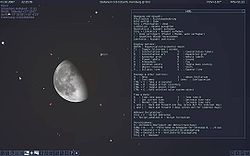Stellarium
| Stellarium
|
|
|---|---|

|
|
 The moon under Stellarium 0.9.0 |
|
| Basic data
|
|
| developer | Stellarium development group |
| Publishing year | 2001 |
| Current version |
0.20.2 ( June 22, 2020 ) |
| operating system | Windows , macOS , Unix derivatives |
| programming language | C ++ ( Qt ) |
| category | Astronomy program |
| License | GPL ( Free Software ) |
| German speaking | Yes |
| www.stellarium.org | |
Stellarium is a free astronomy program under the GNU General Public License for simulating a planetarium . The software runs on Microsoft Windows , macOS and GNU / Linux .
Stellarium was programmed by the French Fabien Chéreau. Many graphics and images in the program are from other authors.
Functions
Using OpenGL , a photo-realistic starry sky with over 600,000 stars is displayed in real time , whereby the location and time as well as the spatial angle can be freely selected. It shows stars and other astronomical objects that can be seen with the naked eye , binoculars or a telescope . The star catalog can be expanded up to the 18th magnitude and thus to over 210 million stars.
Some outstanding features are an almost photo-realistic sunrise and sunset , lunar and solar eclipses , meteors and graphics of planets , nebulae and galaxies . Stellarium also shows the change in the shape of the constellations over millennia . Animations can also be generated. Scripts can be defined for this (sample scripts are included). The background can be changed so there are different locations on earth and planets available.
In order to be able to observe in a targeted manner, stars can be removed, for example, deep-sky objects (galaxies, star clusters, nebulae) can be displayed or the atmosphere and ground can be hidden.
The program can also display constellations .
Web links
Individual evidence
- ↑ stellarium.org . (accessed on August 9, 2017).
- ↑ Release 0.20.2 . June 22, 2020 (accessed June 26, 2020).